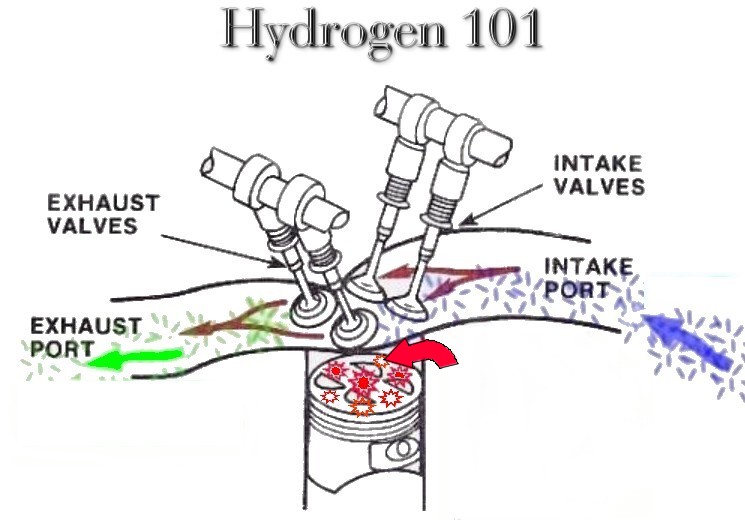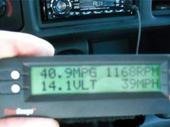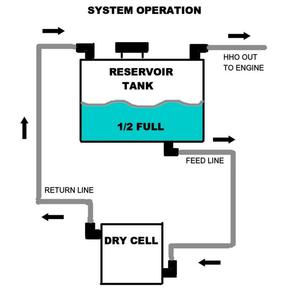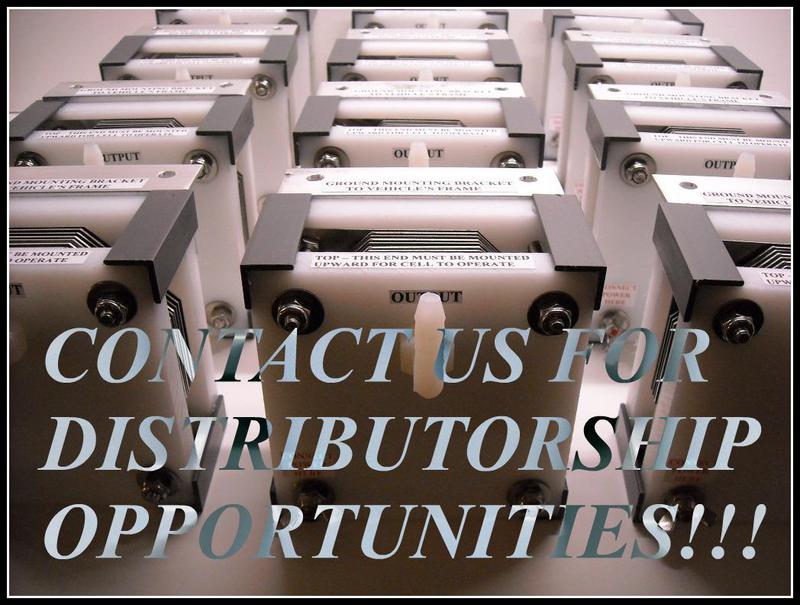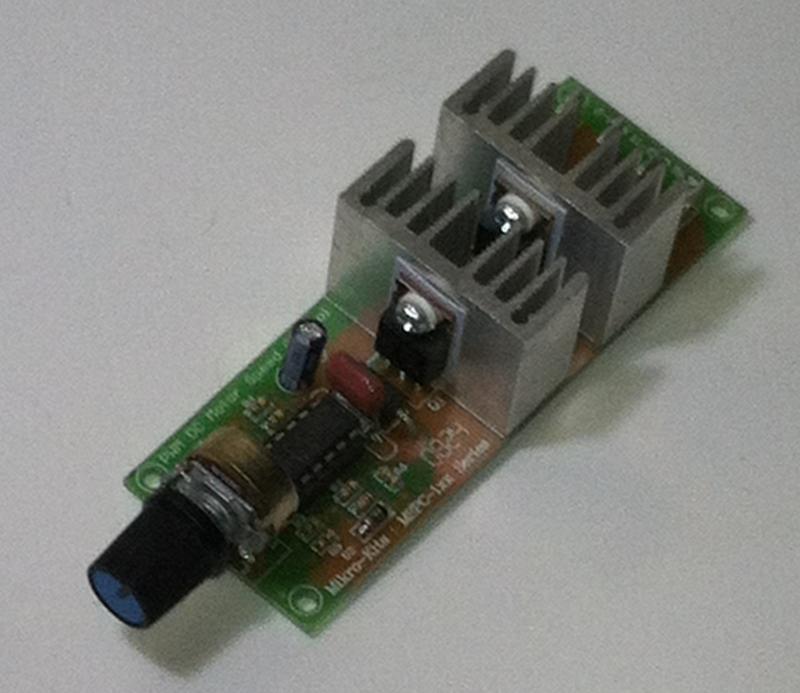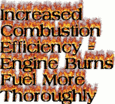 | ||||||
 | ||||||
 | ||||||
 | ||||
 | ||||||
 | ||||||
 | ||||||
 | ||||||
 | ||||
 | ||||
 | ||||
 | ||||
Alternative MPG - Alternative Fuel Research and Development Team - US Based Company - Copyright 2014 - Proud Subsidiary of Alternative R&D - VA, US Co.
HOW IT ALL WORKS:
Let's start from the beginning: HHO is the abbreviation for Hydrogen and Oxygen gas. A Hydrogen fuel cell (also known as a dry cell generator or electrolyzer) functions by splitting water into individual Oxygen and Hydrogen atoms. Two Hydrogen atoms and one Oxygen atom are produced from each molecule of water through the process known as electrolysis. This process begins once electrical current is applied to the cell, which is filled with a mixture of pure distilled water and electrolyte (Potassium Hydroxide - also called KOH.) This combustible gas is then drawn into the engine through the vehicle's intake. The HHO then combines with the fuel which is used to power the vehicle (gasoline or diesel) to allow a hotter, more complete burn of the fuel in the cylinders. More of the gasoline or diesel fuel is able to be burned due to the presence of HHO in the combustion. Since more of the fuel is being burned, the engine will be able to use slightly less fuel than it would without the HHO. This process results in cleaner emissions and less unburned fuel. All that's required after the system is in place is to keep an eye on the water level in the tank, and periodically refill with water and electrolyte. We have systems available to fit all engine sizes, and you adjust the output yourself. Larger engines require more Hydrogen to achieve gains, whereas smaller engines require less. More electrolyte content in the cell draws more current which equals more Hydrogen output. If you need more HHO, just add more electrolyte. It's that easy!
HYDROGEN FUEL EDUCATION TABLE OF CONTENTS:
* ADJUSTING YOUR ENGINE COMPUTER FOR HHO USAGE:
An extremely important factor of installing an HHO system on a vehicle is adjusting the engine computer for the use of HHO gas. The vehicle's engine computer (ECM) must be adjusted in order to accept the HHO and to properly adjust the air/fuel ratio. Here's how this works: for all fuel injected vehicles, it is necessary to make the required adjustments to the ECM by installing an Electric Fuel Injection Enhancer (called EFIE unit for short). Without an EFIE unit, the ECM will detect a higher than normal amount of Oxygen in the exhaust (the "O" atom in HHO). The Oxygen sensor(s) will see this extra Oxygen and will cause the ECM to believe that the engine is running "lean" so the computer will actually upgrade the fuel output to compensate for this false reading. This will result in more fuel output, and decreased fuel economy. The purpose of the EFIE unit is to "trick" the computer into ignoring this Oxygen and actually cutting back the amount of fuel that the engine is using, in order to allow the HHO to replace a small amount of this fuel and increase the vehicle's fuel economy. If the vehicle is fuel injected, then you will definitely require an EFIE device. Here are the two models that we recommend. They are both high quality units which will effectively adapt your ECM for the use and benefits of HHO technology. Although our specialty is the HHO system itself, we do offer EFIE units for use with our systems. Our units will fit most vehicles that are produced after 1996 see the list of vehicles to make sure that yours is listed. If our units will not fit your vehicle, the other manufacturer we recommend offers units for vehicles that were built before 1996 (or for models that our units are not available to fit). Visit the links below to select the EFIE unit that you prefer:
HERE'S WHAT YOU NEED FOR A COMPLETE HHO SYSTEM INSTALLATION:
HHO System = The proper size HHO System for your vehicle. Visit our Products Page to view our systems and select the proper one for your vehicle. Use your vehicle's engine size to choose the proper HHO System.
EFIE unit (Electronic Fuel Injection Enhancer unit) = As important as the system itself. This device is required to adjust the vehicle's engine computer for the use of HHO. Without the EFIE, HHO technology is virtually useless. Click Here to view our state of the art E.F.I.E. Units.
Installation Hardware = We offer an installation kit which contains all of the required wire and electrical components to install your HHO system. Some users prefer to track these parts down at local auto parts stores, and some of our customers already have these items available in their home garage or workplace. The installation kit saves time and cost by providing everything in one package, but is optional depending on the user's preference.
Electrolyte Chemical = The electrolyte allows the dry cell to conduct the electrolysis process, and convert distilled water into Hydrogen and Oxygen when electrical current is applied. The only electrolyte we recommend is Potassium Hydroxide (chemical formula = KOH). Baking Soda, or other electrolytes are not only damaging to the fuel cell, but they are very inefficient and will not produce nearly enough output. Our recommended supplier of KOH is AAA-Chemicals, they offer the highest quality chemicals at the most reasonable prices. We typically recommend starting out with the 2 pound container of KOH - under normal driving patterns, this will usually last a minimum of 6 months to power your HHO dry cell system.
Distilled Water = It is extremely important to use only distilled water in your HHO system. Tap water contains trace minerals, which will cause the internal structure of the dry cell to prematurely deteriorate. Distilled water maintains clean operation, and long life for your fuel cell. Distilled water can be purchased at any grocery store for less than $0.99 / gallon.
Distilled White Vinegar = The bubbler units require this clean, clear type of vinegar to operate properly and effectively. This can be purchased at any grocery store very reasonably. A gallon container will typically last at least 6 months.
WHAT TO EXPECT - WHAT NOT TO EXPECT - FROM AN HHO SYSTEM:
There is a lot of mythology surrounding the use of Hydrogen fuel as a source of alternative energy. A lot of companies make outlandish claims to sell sub-par products to uneducated consumers who are inevitably disappointed when the results fail to live up to the fantastic claims. Our mission is to dispel the myths, provide real-time data, and let the educated consumer make an informed decision based on actual science. Our systems do deliver results, and we like to provide as much actual information regarding their use and advantages as possible.
Let's start out by explaining what NOT to expect from an HHO system installation:
We receive a lot of questions regarding running a vehicle completely on water. We're not going to say that this is impossible, but this is not possible with today's technology. An HHO System is not a conversion to allow your vehicle to run on HHO. It is a supplemental fuel source. HHO allows your vehicle's normally used source of fuel to be used more efficiently, and thus achieve more miles per gallon. Click here for the particulars of how HHO increases your vehicle's fuel efficiency. This technology is a very effective way to get the most out of your normally used fuel, and it does work. No question about that. We have installed literally thousands of systems on thousands of vehicles. There is no question that HHO is an extremely effective source of alternative energy, but here is what not to expect from a system installation:
HHO does not replace the existing fuel source - your vehicle will not "run on water." HHO is a supplemental fuel, that assists the primary source of fuel and allows the engine to operate more efficiently.
HHO is not a simple "plug & play" installation, where you install the system and automatically achieve a huge boost in fuel economy. HHO systems take tuning and adjustment, but are able to increase the efficiency of your engine with the proper adjustments being made.
HHO will not provide an incredible mileage increase. We've seen companies that claim: "50% increases" and other fantastic results. Our recommendation is to be very careful of dealing with any manufacturer that makes these fictional claims, because they are obviously just trying to sell a product based on unethical advertising. The truth is that no modification to a vehicle will give you a 50% increase (short of installing an electric drive hybrid configuration). This is not a technology that allows the fuel gauge to stand still while the miles roll by on the odometer. HHO does provide increased fuel economy, but the reality is within the 14-25% increase range. We have recorded this data based on thousands of successful installations.
HHO will not reduce your emissions to "0". These types of claims are also false. Burning HHO in the cylinders will have a positive effect on the emissions ratings of an engine, since the increased combustion efficiency reduces the amount of unburned fuel in the exhaust, but the emissions are still within the realm of "normal" however slightly improved over what they would be without HHO installed.
Here's what HHO technology can accomplish. Our company takes pride in providing honest, truthful information about this science so that our customers can be correctly informed and have realistic expectations about what HHO can accomplish:
Installing an HHO system will increase the engine's fuel economy. As previously stated: a typical result with a successful installation will be in the range of 14-25% with the proper modifications to the vehicle's engine computer. For example: a Dodge Ram 1500 with a 5.7L 360 test vehicle has a typical highway mileage of 15-17 mpg. With our L-2 (Dual Cell) Fuel System installed, the highway mileage was recorded consistently between 18-21 mpg. This is a solid 20% increase in fuel economy, which provides a savings of 15 gallons of fuel over 3 tanks driven. Pretty respectable for a modification that costs less than $400 to install and only about $3/month to maintain!
Installing HHO on a vehicle will cause a slight performance increase. Not enough to make the pro-circuit in the 1/4 mile, but the systems will slightly increase low-end throttle response.
Installing an HHO system will decrease carbon buildup in the engine, and actually increase engine lifespan through cutting down on Hydrocarbon production and allowing a more complete burn of the fuel in the cylinders. Emissions are positively affected, in that with enough vehicles using this technology - the planet would indisputably feel a decrease in the negative impact (both through the decrease in harmful emissions output, as well as the enhanced efficiency of the usage of fossil fuels.
The bottom line is that no such "do-it-yourself" modification available to the public today can provide as much of an increase in economy with as low of an initial investment as HHO technology. Our systems are more comprehensively engineered and durable than any others available - this is why we've been #1 in the field for over 6 years.
Basics of a Dry Cell Fuel System:
An HHO Dry Cell System is the most advanced, efficient method for producing Hydrogen gas through the process of electrolysis. As compared to a "wet cell" system, this configuration is far superior. The name can be slightly misleading, since dry cell HHO systems are not actually "dry". They still contain water, and use electrolyte to create HHO gas - the name "dry cell" refers to the physics principle of a multi-chambered unit that contains the solution in individual spaces and moves the liquid through the cell via the process of heat convection. The fuel cell (or dry cell) circulates the electrolyte solution from back to front when electrical current is applied. The solution (KOH and distilled water) is stored in the reservoir tank where it flows down the feed line to the cell's input fitting. As the cell is powered on, the water is circulated through the chambers inside the fuel cell where the HHO is produced. As the solution leaves the cell through the output fitting, combined with the HHO gas, it flows up the return line to back to the reservoir tank. When the HHO and solution reach the reservoir, the gas separates and rises to the top of the tank, then exits through the output fitting to the vehicle's engine. The solution remains in the reservoir tank, and then starts the cycle over again & flows down the feed line back to the cell. Dry cell systems are self-circulating - no pump is required. The fuel cell circulates the solution on its own once the systems is powered on. Dry cell systems not only produce higher volumes of HHO gas when compared with wet cell generators, but will not "boil-over" like wet cells. Dry cell systems are able to maintain their temperature and amperage setting, since the solution has a chance to cool while is spends only part of its time in the fuel cell. This is the basic principle of operation of a dry cell system - our systems take this a step further, implementing a cooler which allows the temperature to stay even lower than a typical dry cell setup. Lower temp means a longer life-span for the system, and enhanced protection for your engine. Our bubbler units add a degree of protection for your engine by filtering the HHO gas through a neutralizing solution before it enters your engine. The bottom line: HHO dry cell systems are by far the most advanced HHO systems available - and OUR dry cell systems are the most advanced versions of Dry Cell HHO systems available.
Which HHO Fuel System Do I Need for My Vehicle?
This is by far the most common question that we receive. The size of your HHO Fuel System that you will require is determined by the engine size of your vehicle.
Visit our Products Page to view our systems and select the proper one for your vehicle. Use your vehicle's engine size to choose the proper HHO System.
Our recommendations are listed below:
Engine Size of less than 4.5L = Single Cell Fuel System
Engine size between 4.5L and 7L = 2 Cell Fuel System
Engine size of larger than 7L = 3 Cell Fuel System
* Using a larger HHO System on a smaller engine will not increase results, it is honestly just "overkill" and a waste of cost. It is important to match the proper size HHO System to the recommended engine size. If you find that you require more HHO production, you can always add additional fuel cells to the system at any time.
We also have some other product options available, and the recommended usages are listed below:
HHO Starter Kits = These are recommended to users who are new to HHO technology, and do not want to start out with a complete system for their first installation of a Hydrogen System. The Starter Kits offer a cost effective way to get started and learn the basics of how HHO technology works, however they are not recommended for extended use. You will want to add in the system cooler and bubbler tanks once you become familiar with how the system operates. If you are confident that you would like to use HHO on your vehicle for an extended period of time, then we would recommend starting out with a Complete System, instead of a Starter Kit.
2-CELL HHO Starter Kits = For users who are new to HHO technology, for vehicles with engines larger than 4.5L. These systems are for those who may not want to start out with a complete system for their first Hydrogen experiments. These offer a cost effective way to get started and learn the basics of how HHO technology works with a multi-cell setup, allowing you to begin with a higher volume of HHO gas than with a 1-cell system. Starter Kits are not recommended for extended use. You will want to add in the system cooler and bubbler tanks once you become familiar with how the system operates. If you are confident that you would like to use HHO on your vehicle for an extended period of time, then we would recommend starting out with a Complete System, instead of a Starter Kit.
How difficult is an HHO System to Install?
This is another common question that we receive very frequently. The difficulty of installing an HHO system would have to be rated at: moderate. If you have little or no mechanical experience, and are not familiar with your vehicle's mechanical operation - then we would probably not recommend purchasing an HHO system.
If you have some mechanical knowledge, and are familiar with electricity then you should not have much trouble installing a system on your vehicle. There is some technical experience required to complete the task of the installation.
We can most accurately compare the installation of a system to the difficulty of installing a complete stereo in a car. If you are able to install the CD Player, speakers, amplifier, and complete the associated wiring, then you should be able to install and operate an HHO System without too much trouble.
Our illustrated installation manual explains everything in detail to help make the installation as straightforward as possible.
How much maintenance is required for an HHO System?
The maintenance for an HHO System is fairly minimal. All that is required once the system has been installed on your vehicle is to keep the level of distilled water maintained in the system, and to keep an eye on the amperage value so that when it declines you can add more Potassium Hydroxide to the system. You will not have to refill the Potassium Hydroxide every time you have to refill the water - the chemical lasts fairly long in the system. Typical refill of electrolyte chemical is about every 2-3 refills of water. For most vehicles, you can check the water level in the reservoir every 1/2 tank of fuel to see if you need to refill. This is usually plenty, however your driving habits will effect how quickly the system needs to be refilled.
Every 2-3 months, we recommend draining the system, flushing out with distilled water, and refilling with new distilled water and Potassium Hydroxide.
The maintenance program for a system is relatively simple and does not require too much attention, however some tuning and monitoring is required.
Do I need a PWM to use with my HHO System?
If you are not familiar with PWM units, then there is no need to learn about these. This abbreviation stands for Pulse Width Modulator unit. We receive many questions asking whether a PWM unit is required with our systems. The answer to this question is very simply: "NO". If you are using one of our Dry Cell HHO Systems, then you can save the cost of a PWM unit. There are a lot of companies that swear by these devices, and stress the point that they must be used with any HHO system. This is 100% false. They do not increase the gas production of the system, and are only required if you are using a "wet cell" HHO generator. Wet cell HHO systems are very amateur models, and have problems with chronically overheating. Wet cell HHO generators will experience a rise in temperature as the system operates, and with the temp increase the amperage also will rise. After running a wet cell system for about 30 minutes, the amperage value will be approximately twice what it was when you started the vehicle. The PWM device allows you to turn down the amperage as you drive, to prevent these types of systems from boiling over and causing damage to your engine. Our Systems maintain their temperature and amperage value, so this type of device is not required with our HHO systems. The amperage will stay where you originally set it (plus or minus a few amps), and our systems temperature will stay within the safe range of operation, so the system takes care of its own safety standards without having to add a PWM unit into the configuration. If you were to use a wet cell system, then you would require one of these devices. With our advanced dry cell systems, you will not.
Click the Links Below to Learn More About Each Topic:
Do I need a "Flashback Arrestor" with my HHO System?
If you are not familiar with this concept, then no need to be concerned. These units are basically a safety step that was invented to use with early HHO systems to protect against rupture of the system. Our units do not require this component to be added into the configuration. The bubbler unit protects against any potential ignition from entering the HHO system's reservoir tank and causing any potential danger. The concept itself is somewhat ridiculous, as there are no sparks present in the intake of the vehicle near the air filter. (The input for the HHO gas is installed in the intake pipe of the engine, between the air filter and the throttle plate). Some manufacturers claim that you will require one of these arrestor devices to be installed in the gas output of the system (where the HHO enters your engine), however this is really just another unnecessary component that allows them to charge more money for the system. There is no potential danger of sparks from the cylinders entering the intake pipe past the throttle plate. In case of any possible such scenario, our bubbler unit provides more than adequate protection for your HHO system, so this is another area where you can save cost and labor by not requiring this device with your system. Everything that you need for a safe installation is included with our fuel systems.
Interested in Becoming a Distributor?
If you are interested in becoming a distributor of our HHO Systems, now is the time to act. We are currently still accepting applications for new distributorships, however the spots are limited and we are quickly reaching our capacity. We have taken on over 35 new distributorships in the past 2 months, and our space is quickly reaching capacity. We offer discounted pricing for our distributors and order priority (we ship your orders first!). The process of signing up to become a distributor is first to purchase your own HHO System or Fuel Cell. (It is suggested for you to install and operate one of our systems on your own vehicle to become familiar with how the technology and the systems work - an extremely important part of successfully reselling our Fuel Systems is understanding the operation and installation process). Once you have made an initial purchase at retail price of any one (1) of our HHO Systems or HHO Fuel Cells, please contact us and we can send you our new distributor orientation file. There is NO SIGNUP FEE (for now - this will be added in the coming months, but those who are signed up before a fee is added will remain exempt from any signup charge or membership fees). Once you have reviewed our distributorship orientation file, and agree to the terms and conditions, we will send you the signup form and add you to our database. That's it! From that point forward, you will receive your access code, and can enter our distributorship website and make your future purchases at discounted pricing to resell to your customers. We also offer drop-shipping services, where you simply sell the products to your customers at the prices you determine, place the order with us, and we ship straight to them (with your company name and return address on the package). You basically turn a profit without ever having to even stock the parts. Or, if you prefer we can also ship the items to you for you to resell. The options and opportunities are limitless. We have some distributors that routinely sell 30+ fuel systems per week! Act soon before the spaces are filled!
If links do not open, try turning off your web browser's pop-up blocker.
If link does not open, try turning off your web browser's pop-up blocker.
NEW:
and
 | ||||
Your Name:
Your Email:
Topic of Message:
Enter Your Question:
Questions? Use the Form Below to Contact Us Directly:
Re-type Email:
